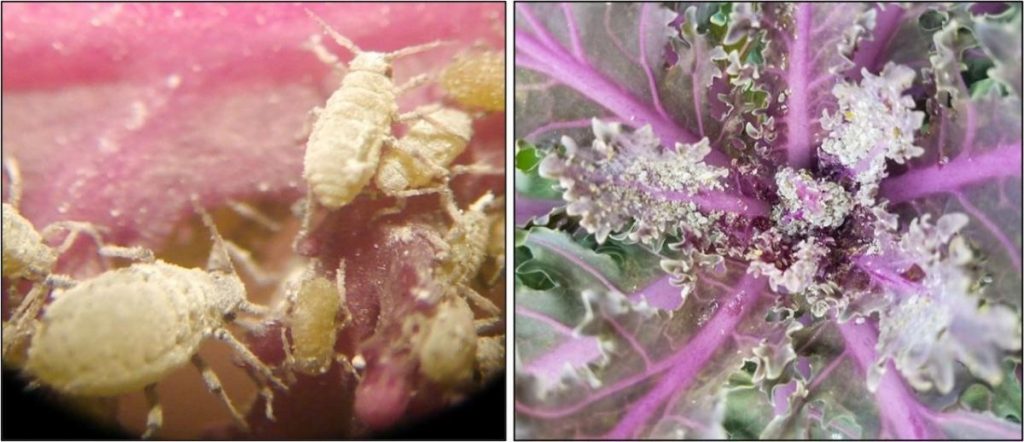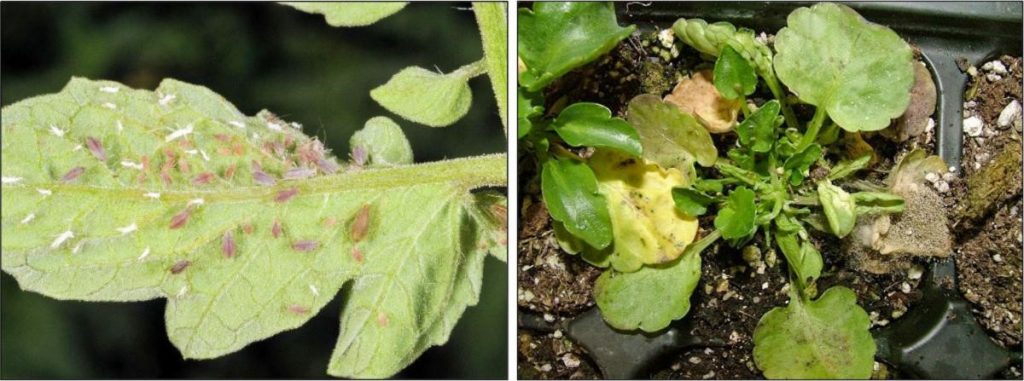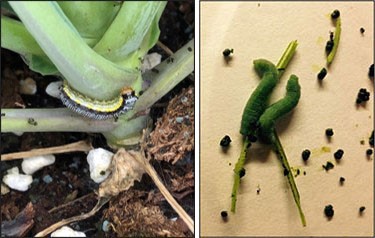Two Key Pests: Aphids and Caterpillars
Believe it or not, fall is already right around the corner. Fall pansies along with ornamental cabbage and kale are among the popular grown crops during this time of year. There are two keys pests that these crops have in common, which are aphids and caterpillars. Both pests can be relatively easy to scout for and identify, however, if left unchecked, they can quickly take away from the overall quality of your crop. This brief article will outline how to identify signs of both aphids and caterpillars as well as provide effective chemical and biological control options.
Identifying and Controlling Aphids
Aphids attack almost every species of edible and ornamental plant. Although they can vary widely in shape, color, and size, there are a few distinct characteristics of aphids that can help your team identify their presence before an outbreak occurs. Aphids are most often pear-shaped with six legs, two antennae, and two spikes coming out of their rear called cornicles. Aphids prefer to predate on tender, newly developing foliage. They can group together in large numbers and at different life stages (Figure 1). Using their piercing-sucking mouthparts, their damage can cause a distorted curling or stippling of the terminal growth.

Along with their ability to reproduce asexually in large numbers quickly, they can reach maturity within 10 days at 72F. This does indirectly provide a benefit when trying to scout for aphids as they leave behind a white molted/cast skin that is easy to see with the naked eye (Figure 2). If aphids are left to feed and reproduce freely, they will indirectly leave another calling card which is sooty mold development which feeds on the excrement or “honeydew” the aphid drops onto the foliage. In extreme situations, other foliar pathogens such as Botrytis can also develop (Figure 3). Aphids can be controlled by rotating between various modes of action (MOA) and/or using biological control agents (BCA). Some effective foliar spray options include: Altus (4D), Aria (29), Endeavor (9B), Hachi-Hachi (21A), Kontos (23), Pradia (28/29), Rycar (9B), Tristar (4A), and XXpire (4C/5). Substrate drenches can also be used for longer residual control which include Endeavor (9B), Kontos (23), Mainspring (28), Imidacloprid-based products (e.g., Mallet, Marathon 9A), and Safari (9A). Biological control agent options include parasitic wasps Aphidius colemani and Aphidius ervi along with predator species Aphidoletes and Chrysoperla (green lacewings).

Figure 3: Pansy crop with aphid damage and honeydew leading to sooty mold and Botrytis
Identifying and Controlling Caterpillars
Similar to aphids,caterpillar species vary widely in appearance, however, their general worm-like look and voracious appetite is unmistakable. Caterpillars use a chewing mouthpart to consumer entire stems and foliage in a short period of time. Holes, incisions, or entire missing leaves chewed away by caterpillars is the easiest way to determine they are present in the crop. As they feed, they will leave their waste product known as “frass” around the feeding area, similar to how aphids leave honeydew on the foliage (Figure 4). Fortunately for growers, many of the MOA’s recommended for aphid control will also be effective at controlling caterpillar species (e.g., Hachi-Hachi, Pradia, Mainspring, Tristar, Safari, and XXpire). Other pesticide options include Acelepryn (28), BT NOW (11A), Decathlon (3A), DiPel Pro (11A), Discus (3A/4A), Pyganic 5.0 Specialty (3A), and Sarisa (28). For a BCA strategy, Trichogramma, a species parasitic wasp can be released using eggs on cards or bridgeable capsules.
There are many effective chemical and BCA options available on the market, which can be somewhat overwhelming. If you should have any questions or are in need of recommendations on specific products, rates, or application intervals, please feel free to reach out to your local Griffin sales representative of contact GGSPro at 800-888-0054 ext. 89129 or email us at ggsprotech@griffinmail.com. It is important to note that is the grower’s responsibility to follow all label instructions when applying pesticides to ensure employee and plant safety. Products other than those mentioned in this article may be safe and effective.

& caterpillar feeding with left over frass (right)